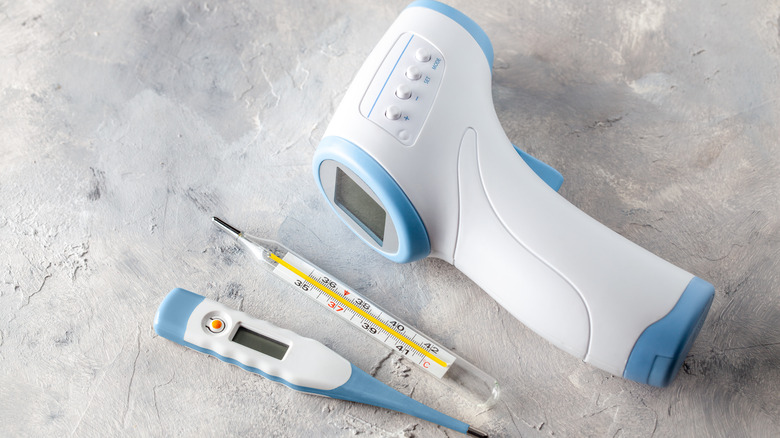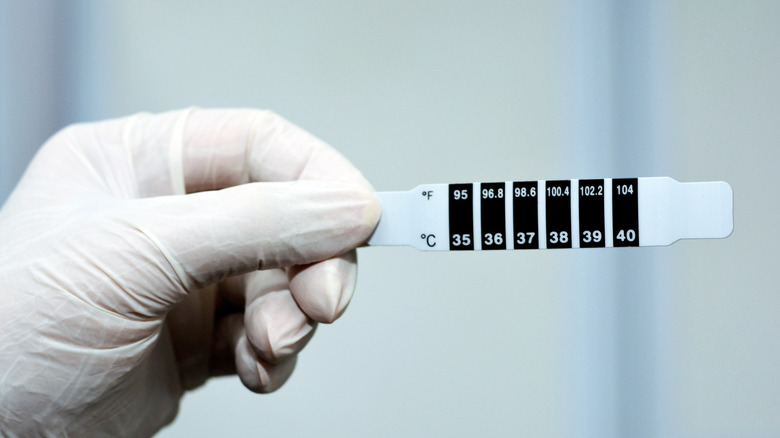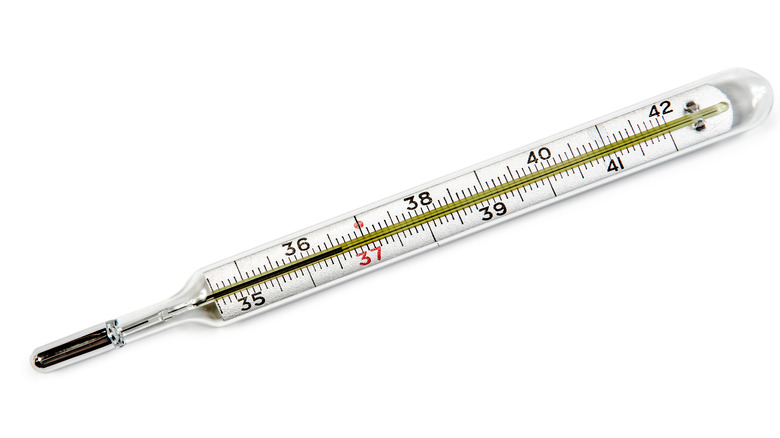How And When To Use Every Type Of Thermometer
When you are not feeling well — especially if you feel hot or have symptoms like chills, headaches, or loss of appetite – it can be an indicator that you are sick. When you have a bacterial or viral infection, one way the body fights it off is by causing you to run a fever. When you have a fever, according to WebMD, your body temperature rises above normal in order to kill the source of the infection.
The Mayo Clinic says the average human body temperature is around 98.6 degrees Fahrenheit (37 degrees Celsius). However, it is entirely normal for your temperature to vary between 97 degrees F (36.1 degrees C) and 99 degrees F (37.2 degrees C). Body temperature can vary throughout the day due to factors like how active you are and what time of day it is, they explain.
The best way to check for a fever is by using a medical thermometer. According to TriMedika, a medical thermometer is designed to provide accurate readings. There are two general types of medical thermometers that are used: contact and remote.
Contact thermometers
The Mayo Clinic explains that contact thermometers are those which must touch the skin in order to take a temperature reading.
Thermometers that use electronic heat sensors are the most common type. These thermometers generally provide a digital readout showing the temperature reading. The Cleveland Clinic notes that digital thermometers are both quick to use and accurate.
Old-fashioned glass thermometers are also contact thermometers. Tec-science says these thermometers are based on the idea that substances expand when they are heated. When the heat from your body causes the temperature of the liquid inside the thermometer to rise, the liquid expands and moves up a glass tube that is marked off in degrees, providing a temperature reading. They are less commonly used now, however.
Temperature readings that are done with a contact thermometer are generally done via the forehead, mouth, armpit, or rectum, according to the Mayo Clinic. They note that rectal temperatures are the most accurate for babies and toddlers. Temperatures taken under the armpit are generally the least accurate.
Remote thermometers
Remote thermometers, on the other hand, are thermometers that don't require skin contact. They have become popular for use in settings like schools, clinics, and businesses due to the fact that they can rapidly screen people for fevers without requiring people to get too close, says the Mayo Clinic.
These thermometers work by using an infrared scanner to measure temperature, either in the temporal artery in the forehead or inside the ear.
Remote thermometers have certain advantages, such as being quick and comfortable to use. However, they can also be more expensive and may be less accurate under certain conditions. For example, direct sunlight, a cold environment, sweaty skin, or holding the scanner too far away can all affect the accuracy of forehead scanners. Additionally, the accuracy of ear thermometers can be affected by the presence of earwax. It can also be affected by the size of the ear canal, so they are not appropriate for use in newborns.
Choosing a thermometer
Medical EXPO suggests that there are four criteria to look at when you are deciding which type of thermometer is right for you: where the measurement is being taken, what type of thermometer it is, how comfortable it is to use, and what kind of health and safety measures that you might need to take.
The location of the reading is especially important with children. Parents writes that rectal thermometers are the most accurate in children under three. However, an oral thermometer can be better for an older child who can keep their mouth closed with the thermometer under their tongue. Ear and forehead thermometers can be better choices if you need quick results or your child doesn't like having his temperature taken. Taking a child's temperature under their armpit can be helpful if they won't tolerate having something in their mouth.
According to the Mayo Clinic, a remote thermometer can be helpful when you need to take a temperature quickly. However, the trade-off is that they are more expensive and may be less accurate.
Comfort can be an issue with babies and children, in which case a pacifier or remote thermometer may be beneficial.
Finally, there may be safety issues to consider. For example, a remote thermometer can be a better choice for businesses and schools since there is no skin contact and therefore less potential for transmitting an infection.
Why you should avoid strip thermometers
Strip thermometers, which consist of a flat plastic strip that is placed on the forehead, can be very tempting to use. They are very inexpensive. Also, they are quick and easy to use, even on a child that is sleeping. You just lay them across the forehead and wait a couple of minutes for the heat-sensitive liquid crystals in them to change color.
However, according to The Centre for Evidence-Based Medicine (CEBM), this is one type of thermometer that you will want to avoid if you need to get an accurate reading. They simply don't work very well. Temperatures taken with a strip thermometer can vary by at least plus or minus 1.5 degrees C, says the organization. They further indicate that strip thermometers will miss about 40% of fevers. WebMD describes the results obtained from strip thermometers as being "at best, a ballpark figure."
What about mercury thermometers?
Medical EXPO says that although analog glass thermometers used to be the standard method of taking a temperature, they are now being used less often. It really comes down to two reasons, they write. First of all, they are more difficult for people to read. Secondly, since they are made of glass, they can easily break.
Healthline notes that mercury thermometers in particular have fallen out of favor because of mercury's toxicity. Unless you have an older thermometer, the liquid in your thermometer may actually be a mixture of gallium, tin, and indium, says Medical EXPO. If it contains a red fluid, then it contains alcohol, according to Healthfully. Poison Control recommends assuming that your thermometer contains mercury if the contents are silver and it is not specifically labeled as being mercury-free. These thermometers cannot be simply thrown in the garbage.
Guidance from the U.S. Environmental Protection Agency (EPA) states that broken mercury thermometers should be carefully cleaned up and disposed of as hazardous waste. They recommend contacting your local health department, municipal waste authority, or fire department to learn how to dispose of mercury-containing thermometers properly.






